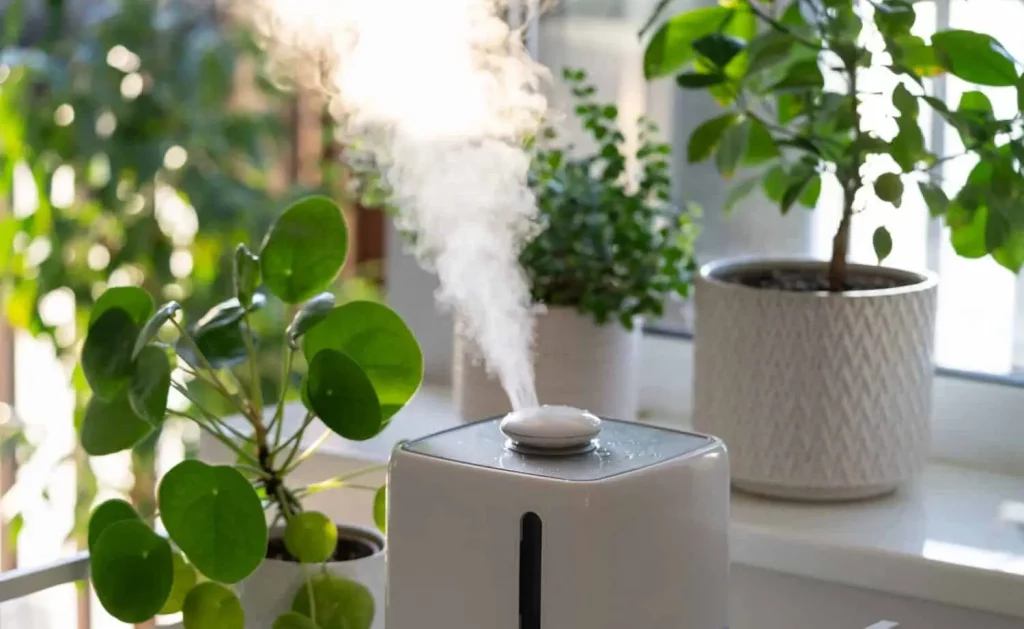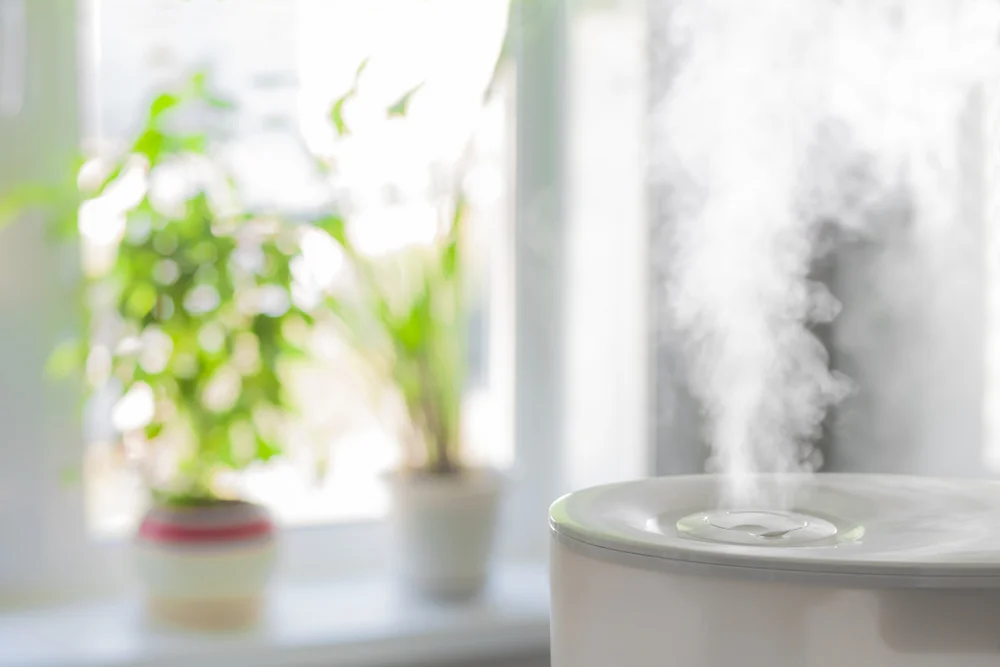Contents
- 1 Best Smart Humidifiers for Indoor Plants (Set Ideal Moisture Automatically)
- 1.1 Why Indoor Plants Need Humidity Control
- 1.2 How Smart Humidifiers Work
- 1.3 Top Features to Look For in a Smart Humidifier
- 1.4 Best Smart Humidifiers for Indoor Plant Care
- 1.5 Where to Place Your Smart Humidifier
- 1.6 Combining Humidity Control with Airflow
- 1.7 Seasonal Humidity Tips
- 1.8 Cleaning and Maintenance Tips
- 1.9 FAQs About Smart Humidifiers for Indoor Plants
- 1.10 Final Thoughts on Smart Humidifiers for Indoor Plants
- 2 How to Build a DIY Smart Plant Setup
Best Smart Humidifiers for Indoor Plants (Set Ideal Moisture Automatically)
TECHNOLOGY THAT KEEPS YOUR PLANTS THRIVING
Tired of brown leaf tips, dry air, and struggling plants during winter? A smart humidifier can change everything. These devices automatically adjust the moisture levels around your plants — so you never have to guess when the air is too dry again.
Whether you grow tropical houseplants, bonsai, or herbs, maintaining the right humidity is just as important as watering or light. Smart humidifiers make it effortless — balancing air moisture 24/7 for stronger roots, glossier leaves, and faster growth.
Why Indoor Plants Need Humidity Control
Humidity plays a critical role in plant health — it’s what keeps leaves supple, stomata open, and nutrient uptake efficient. Most indoor plants, especially tropical ones, thrive in 50–70% humidity.
When the air is too dry:
Leaves develop brown, crispy tips
New growth curls or wilts
Soil dries out too quickly
Growth slows, even with regular watering
This is where smart humidifiers come in. They monitor the air in real time and release just the right amount of moisture — no guesswork, no over-humidifying, no daily refills.
Learn how humidity affects growth in How to Balance Humidity for Indoor Plants (Avoid Dry Air & Leaf Curl).

How Smart Humidifiers Work
Smart humidifiers use built-in sensors (or external ones via Bluetooth/Wi-Fi) to track humidity in your room. When air moisture drops below your set target — say, 55% — the humidifier automatically turns on and mists the air until optimal levels are restored.
Some advanced models also integrate with:
Mobile apps (so you can monitor humidity remotely)
Voice assistants like Alexa or Google Home
Auto shutoff sensors to prevent over-humidifying
They’re perfect for anyone who wants consistent humidity without constant manual adjustment.

Top Features to Look For in a Smart Humidifier
Not all humidifiers are made for plant care. When choosing one, look for features that make life easier and growth stronger:
1. Built-In Hygrometer
Tracks humidity levels accurately and adjusts automatically.
2. Long Runtime
Look for tanks that last 20–40 hours to avoid frequent refills.
3. Cool Mist Output
Safe for both plants and furniture; prevents mineral buildup.
4. Adjustable Nozzles
Direct mist toward plant clusters for efficient coverage.
5. App Control & Scheduling
Set humidity goals, timers, and monitor remotely.
Top-rated smart humidifier like the Levoit Classic 300S can be found on Amazon. They automatically regulate humidity, making them ideal for large indoor plant collections.
Best Smart Humidifiers for Indoor Plant Care
1. Levoit Classic 300S Smart Humidifier
Coverage: Up to 500 sq ft
Smart Features: Wi-Fi, app control, voice assistant compatible
Why It’s Great: Extremely quiet, consistent humidity output, and safe for 24-hour use.
Best For: Tropical plants, ferns, and Calatheas.
2. TaoTronics Smart Cool Mist Humidifier
Coverage: Medium rooms (up to 300 sq ft)
Features: Auto humidity mode, LED display, 360° mist nozzle
Why It’s Great: Affordable, reliable, and energy efficient.
Best For: Small plant collections or bedrooms with potted plants.
3. Dyson AM10 Humidifier
Coverage: Large areas (up to 600 sq ft)
Features: UV light sterilization, even mist distribution
Why It’s Great: Premium design with medical-grade hygiene standards.
Best For: Large homes or plant rooms needing sterile, even humidity.
Where to Place Your Smart Humidifier
Placement makes a big difference in effectiveness and safety.
✅ Ideal Spots:
Near plant clusters or shelves (1–2 ft away).
In the same room but not directly under leaves.
Close to a power outlet for convenience.
🚫 Avoid:
Placing directly on wooden surfaces (use trays).
Putting too close to electronics or walls.
Over-misting enclosed areas with poor ventilation.
💡 Aim for a gentle, even mist rather than a concentrated jet — it should mimic natural humidity, not a fog machine.
Combining Humidity Control with Airflow
Balanced humidity is powerful — but airflow keeps it healthy. Stagnant, moist air can lead to mold or fungus. To prevent this:
Use a small oscillating fan to circulate air.
Open windows for 15 minutes daily (weather permitting).
Avoid over-clustering plants in tight corners.
For added control, pair your smart humidifier with a smart plant sensor (like Xiaomi or SwitchBot). These sensors sync data to your phone, ensuring every plant gets the perfect mix of moisture, air, and temperature.
Seasonal Humidity Tips
🌨️ Winter:
Dry indoor air? Run your humidifier daily and keep plants away from heaters.
☀️ Summer:
Humidity is naturally higher — reduce runtime and increase ventilation.
🍂 Autumn & Spring:
Transition periods — ideal for resetting your humidity targets and cleaning the humidifier.
Gardenersworld – How to Increase Humidity for Houseplants
Cleaning and Maintenance Tips
Humidifiers work best when they’re clean. Mineral buildup and bacteria can harm both your device and your plants.
🧽 To keep yours running efficiently:
- Empty and refill daily with distilled or filtered water.
- Clean the tank weekly with white vinegar and warm water.
- Replace filters or wicks monthly if applicable.
- Dry the tank completely when not in use.
🪴 Pro Tip: Use a humidifier cleaning brush kit — available on Amazon — to reach hard-to-clean areas and prevent mold buildup.
FAQs About Smart Humidifiers for Indoor Plants
1. How often should I run my smart humidifier?
Most plants do best with 4–6 hours of misting daily, but smart models handle this automatically based on your set humidity level.
2. Can I use essential oils in it?
Avoid them unless the humidifier specifically allows it — oils can damage sensors and plant leaves.
3. What humidity level should I set for tropical houseplants?
Keep it between 55–65% for most species like Monstera, Peace Lily, and Philodendron.
Final Thoughts on Smart Humidifiers for Indoor Plants
A smart humidifier takes the guesswork out of plant care. By automating one of the most crucial yet overlooked aspects — air moisture — it helps your indoor jungle grow stronger, glossier, and more resilient to stress.
No more brown tips. No more daily misting. Just perfect humidity, all year long.
Smart gardening starts with smart humidity — and your plants will love you for it.
Related Articles
UPGRADE YOUR PLANT CARE ROUTINE
How to Build a DIY Smart Plant Setup
Discover how to automate watering, lighting, and humidity control with simple smart tools — perfect for modern indoor gardeners.

